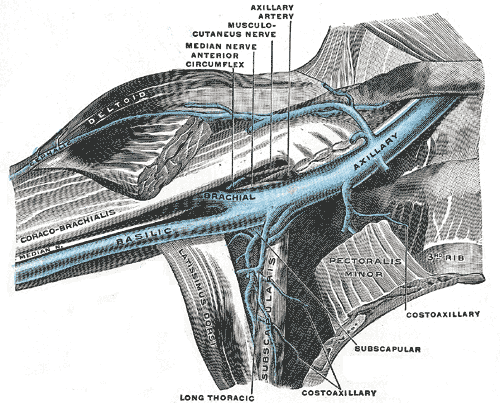Paget-Schroetter disease
| Paget-Schroetter disease | |
 | |
|---|---|
| Anterior view of right upper limb and thorax | |
| ICD-10 | I82.8 |
| ICD-9 | 453.8 |
| DiseasesDB | 34349 |
| eMedicine | med/2772 |
|
Paget-Schroetter disease Microchapters |
|
Differentiating Paget-Schroetter disease from other Diseases |
|---|
|
Diagnosis |
|
Treatment |
|
Case Studies |
|
Paget-Schroetter disease On the Web |
|
American Roentgen Ray Society Images of Paget-Schroetter disease |
|
Risk calculators and risk factors for Paget-Schroetter disease |
Editor-In-Chief: C. Michael Gibson, M.S., M.D. [1]
Synonyms and keywords: Paget-von Schrötter disease
Paget-Schroetter disease refers to deep vein thrombosis of an upper extremity vein, including the axillary vein or subclavian vein.
Presentation
The syndrome is also known as “effort-induced thrombosis” as it has been reported to occur after vigorous activity, though it can also occur spontaneously.
It usually presents in young and otherwise healthy patients, males more often than females.
Symptoms include sudden onset of pain, warmth, redness, and swelling in the arm. These DVT's should be treated as an emergency, but rarely cause fatal pulmonary emboli.
Treatment
The traditional treatment for thrombosis is the same as for a lower extremity deep vein thrombosis, and involves anticoagulation with heparin (generally low molecular weight heparin) with a transition to warfarin.
However, J. Ernesto Molina, MD, a vascular surgeon at the University of Minnesota, has expressed the following opinion:[1]
"The current acceptable treatment for that condition is lytic therapy followed by surgery. The patients were followed up to investigate the rate of recurrence. However, if surgery is not done, the problem will invariably recur.2–4 If patients are treated with only anticoagulants and even thrombolytics but no surgery, I expect the recurrence rate to be high." Because "most of the patients who suffer this condition do not have any abnormality in their coagulation mechanism" and in fact suffer from "a direct injury to the endothelium," the "treatment for Paget-Schroetter syndrome ... entails the use of thrombolytics followed by surgery to decompress the thoracic inlet and widening of the vein, usually with a vein patch."
Eponym
It is named for James Paget[2][3] and Leopold von Schrötter.[4]
See also
- Thoracic outlet syndrome, a possible cause of blot clots in arms
Trivia
The father of a patient used Google to diagnose his son's Paget-Von Schrötter syndrome by querying on the symptoms, and it resulted in one of the first descriptions of "googling for diagnosis".[5]
References
- ↑ "Letter Regarding Article by Martinelli et al, "Risk Factors and Recurrence Rate of Primary Deep Vein Thrombosis of the Upper Extremities" * Response -- Molina et al. 111 (9): e118 -- Circulation". Retrieved 2007-07-02.
- ↑ Template:WhoNamedIt
- ↑ J. Paget. On gouty and some other forms of phlebitis. St. Bartholomew’s Hospital Reports, London, 1866, 2: 82-92.
- ↑ L. von Schrötter. Erkrankungen der Gefässe. Nothnagel’s Handbuch der speciellen Pathologie und Therapie, 1901. Volume XV, II. Theil, II. Hälfte: Erkrankungen der Venen. Wien, Hölder, 1899: 533–535.
- ↑ Hangwi Tang & Jennifer Hwee Kwoon Ng (2006). "Googling for a diagnosis—use of Google as a diagnostic aid: internet based study". BMJ. 333: 1143–1145. doi:10.1136/bmj.39003.640567.AE. Unknown parameter
|month=ignored (help)